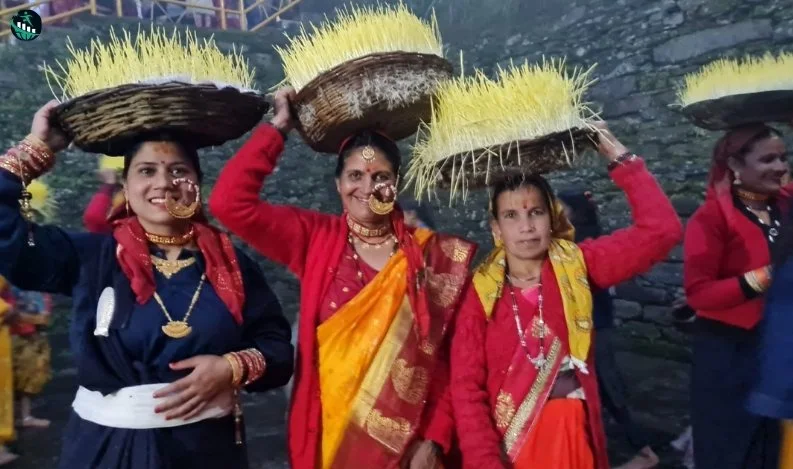
Harela Festival 2024: Celebrating Greenery and Tradition in Uttarakhand
The Harela Festival 2024, a symbol of greenery and prosperity, is celebrated with great enthusiasm during the rainy season in Devbhoomi Uttarakhand. This year, the Harela Festival will take place on the 16th of July, coinciding with Sankranti. Harela heralds the arrival of the Sawan season, embodying wishes for a bountiful harvest, seed conservation, and blessings from elders. Residents of Uttarakhand, both within the country and abroad, send Harela straws as blessings through letters. On this auspicious day, plants are ceremoniously planted throughout the mountainous regions.
Also Read:- Gold Prices Decline as Dollar Strengthens Following Trump Incident
Environmental Significance of Harela Festival
Primarily celebrated in the Kumaon region of Uttarakhand, the Harela Festival is deeply intertwined with the environment. On this day, people can be seen adorning themselves with Harela straws behind their ears. The term "Harela" signifies greenery, reflecting the region’s agricultural dependence. This folk festival, rooted in the conservation of seeds and the fostering of a prosperous environment, has been passed down through generations. During the Harela Festival, it is customary to worship Lord Shiva and Goddess Parvati.
Origin and Rituals of the Harela Festival
In Uttarakhand, the Harela Festival marks the beginning of the month of Sawan. This year, it falls on the 16th of July, when the Sun enters the Cancer zodiac sign. Nine days before the festival, Harela is sown in every household in a basket made of clay or bamboo. The basket is prepared with alternating layers of soil and seven types of grains, such as wheat, mustard, barley, maize, lentil, horse gram, and others. After preparing three to four layers, the basket is kept in the shade and weeded on the fourth or fifth day. Over nine days, ears of grain sprout in the basket, symbolizing Harela. It is believed that the greater the number of ears, the better the crop yield.
Blessings and Traditions of Harela Festival 2024
In many villages, Harela is sown collectively in the temple for the entire community. On the tenth day, Harela is harvested and first offered at the home temple. The eldest son then places the Harela straw on everyone's head, accompanied by the blessing: "May you live long and stay alert, may you spread like the grass. May you grow as high as the sky and as wide as the earth. May you possess the sharp mind of a jackal and shine like the Sun. May you live to an old age, able to grind rice on a stone and walk with the aid of a stick. May you spread everywhere like the grass."
Culinary Delights of Harela Festival 2024
The Harela Festival is celebrated thrice a year: in Chaitra, Sawan, and Ashwin months. However, the Harela in Sawan holds particular significance. The festival is accompanied by the preparation of traditional delicacies such as Pua, Singal (a sweet dish from Kumaon), Urad dal Bade, Kheer, and Urad dal stuffed Puri. On this day, people plant trees in various places, believing that even a broken twig planted in the soil will flourish.
Also Read:- New Study Reveals Exercise-Induced Cognitive Enhancement Can Last for Years
Cultural Reflections of Harela Festival
Harela signifies the close relationship between greenery, mountains, and nature. The festival is celebrated on the first day of Sawan in Uttarakhand. According to Kumaoni culture expert Shikhar Chandra Pant, nine days before the festival, Harela is sown in baskets made of clay or bamboo. The baskets are prepared with layers of clay and seven types of grains, which are then kept in the shade. By the festival day, the baskets are filled with ears of grain, symbolizing Harela. In many villages, this sowing is done collectively in the village temple, with the belief that the more ears of grain, the better the crop yield.
On the tenth day, Harela is harvested and offered first in the home temple. Elders then place the Harela straws on everyone’s head with a blessing: "May you live long and stay alert. Be as high as the sky, as expansive as the earth. Have the intelligence of a jackal, shine like the Sun. Live to an old age, able to grind rice and walk with a stick. Spread everywhere like grass."
Also Read:- Boost Brain Function with These Five Herbs to Enhance Memory Power
Conclusion
On the day of Harela, traditional dishes such as Pua, Singal, Bade made of Urad dal, Kheer, and Urad dal stuffed Puri are prepared. People wear Harela straws behind their ears and send these straws, along with letters, to their children and relatives in distant places as blessings. In many places, clay representations of the Shiva family are also created alongside the Harela basket, adding to the festival's cultural richness.
News Source:- navbharattimes.indiatimes.com



Recent Comments: